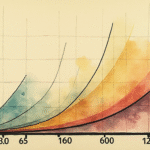Introduction
Telcel, a leading telecommunications company in Mexico with nearly 84 million cellular customers and $2.99 billion in revenue from January to March 2025, has been unable to surpass the percentage of postpaid users it had at the start of the COVID-19 pandemic. This situation has led Telcel to criticize other operators announcing plans to attract postpaid customers, particularly mobile virtual network operators (MVNOs) investing little to no money in infrastructure.
Telcel’s Postpaid User Base
As of March 2025, Telcel has been trying for five years to increase its postpaid customer base relative to the prepaid segment within its overall user base. However, various factors have complicated these efforts, especially during annual interim measurements.
- In March 2025, Telcel had 15.583 million postpaid users, representing 18.57% of its total customers.
- In contrast, postpaid users accounted for 18.86% of Telcel’s total users in the first quarter of 2020.
Having postpaid customers ensures a more stable revenue stream for cellular service providers, which is crucial for Telcel as it pays 6% of its annual total revenue for spectrum licenses and holds 47% of all mobile service spectrum licenses available in Mexico.
Decline in Postpaid Segment
Over the past five years, Telcel’s postpaid segment has experienced a steady decline:
- 18.86% in Q1 2020
- 18.59% in Q1 2021
- 17.93% in Q1 2022
- 17.76% in Q1 2023
- 17.98% in Q1 2024
The first quarter of 2025 still falls below the Q1 2021 data.
Telcel’s Market Position and Challenges
As the best-positioned player in the Mexican cellular market, Telcel’s performance is generally positive across various metrics. However, when these figures are scrutinized, the following trends emerge:
- Revenue increased by 10.10% in nominal pesos from Q1 of the previous five years.
- Average revenue per user (ARPU) rose by 15.58% or 24 pesos.
- Total users grew by 8.69%.
However, when segmented:
- Postpaid grew by only 6.99% compared to prepaid’s 9.08% growth.
- ARPU increased to 178 pesos, a 15.58% rise from 2020’s 154 pesos, equivalent to today’s purchasing power.
- Churn rate improved by 15.38%, indicating fewer users switching to other telecom companies.
Telcel’s Strategies and Challenges
Facing these challenges, Telcel has taken various approaches:
- Advocating for the Mexican government to reconsider spectrum usage fees due to economic slowdowns since 2024.
- Criticizing the legal framework that favors MVNOs like BAIT (Walmart’s telecom venture) using publicly-funded infrastructure, such as Altán Redes, over private investments.
- Telcel’s postpaid segment grew by 3.17% between Q1 2024 and Q1 2025, while AT&T’s postpaid segment expanded by 12.05%.
The impact of potential legal changes allowing the state to allocate spectrum without cost or antitrust concerns remains unclear, especially if BAIT uses this spectrum through a contract with Altán Redes.
Key Questions and Answers
- What is Telcel’s current postpaid user percentage? Telcel’s postpaid users represent 18.57% of its total customers as of March 2025.
- Why is the postpaid segment crucial for Telcel? Postpaid users provide a more stable revenue stream, which is essential for Telcel’s network investments and spectrum license payments.
- What challenges has Telcel faced in growing its postpaid segment? Factors such as economic slowdowns, legal framework disadvantages for established players, and competition from MVNOs using public funds have hindered Telcel’s postpaid growth.
- How does Telcel’s performance compare to other metrics? While Telcel shows positive growth in revenue and ARPU, its postpaid segment’s growth lags behind prepaid, indicating a need for strategic adjustments.






